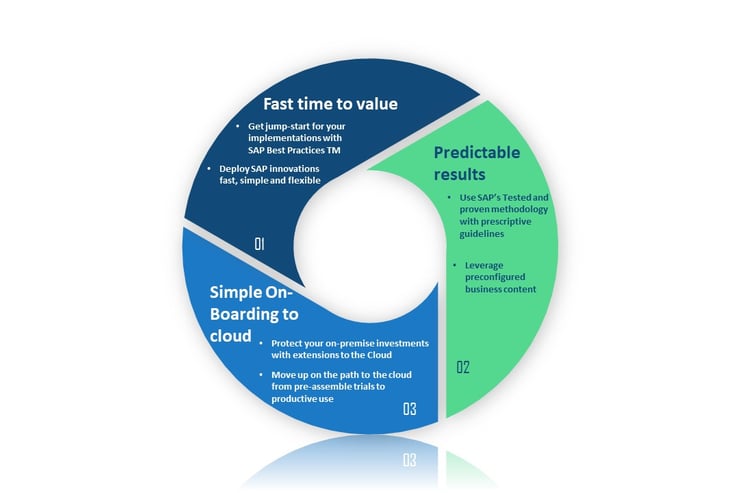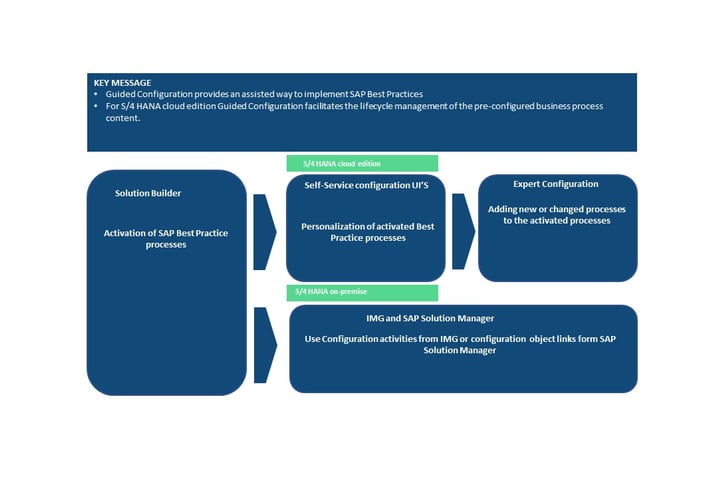SAP Activate
The SAP Activate methodology provides a structured approach to implementing SAP solutions. It is divided into six distinct phases, each designed to guide organizations through the process from initial planning to ongoing optimization.
SAP Activate offers a comprehensive and structured methodology designed to facilitate the deployment, adoption, and expansion of new capabilities throughout your organization. This approach enables you to get started quickly, build intelligently, and operate efficiently. It supports a continuous cycle of innovation, ensuring that your organization remains at the forefront of technological advancements. By leveraging SAP Activate, you can seamlessly integrate and extend new functionalities, ensuring a smooth transition and ongoing enhancement of your systems.
· Streamlined Implementation: SAP Activate offers a clear, structured framework for deploying SAP solutions, including SAP S/4HANA. This helps organizations move through the implementation process efficiently, reducing complexity and time to value.
· Best Practices and Standardization: It incorporates industry-specific best practices and pre-configured business processes to ensure that implementations are standardized and aligned with proven methodologies. This helps achieve consistent and reliable outcomes across different industries and business functions.
· Guided Configuration: The methodology includes guided configuration tools that simplify the setup and customization of SAP systems. This makes it easier for both consultants and customers to configure their SAP environments according to their specific needs.
· Continuous Innovation: SAP Activate supports ongoing innovation by enabling organizations to adopt new features and updates seamlessly. This is especially important in the cloud, where updates and new releases occur frequently.
· Content Lifecycle Management: It provides mechanisms for managing content throughout its lifecycle, ensuring that configuration settings remain stable and are not adversely affected by updates or new versions of the SAP solution.
· User Empowerment: SAP Activate includes self-service options that allow users to configure and customize their systems independently, enhancing flexibility and responsiveness to changing business requirements.
· Comprehensive Support: The methodology offers detailed guidance and resources, including business process flows, roles and responsibilities, and standard test scripts. This support aids in both the initial implementation and ongoing management of SAP systems.
The SAP Activate framework:
SAP Best Practices
SAP has developed and refined a wealth of best practices that are now optimized for SAP S/4HANA. SAP delivers these ready-to-use business processes through a well-documented framework accessible via the Best Practice Explorer. This comprehensive tool includes best practices for integration, migration, and the ability to extend existing processes with custom workflows tailored to your specific needs. The Best Practice Explorer offers valuable resources for both consultants and customers, including detailed business process flows, clearly defined roles and responsibilities, and standard test scripts that double as user guides. This structured approach forms the cornerstone of the SAP Activate framework, ensuring a solid foundation for your SAP implementation.
Guided Configurations
The second component of SAP Activate focuses on guided configurations, designed to simplify the setup process for both consultants and customers within their SAP systems. To promote standardization and global consistency, SAP offers pre-configured business processes that are ready to use right away. For more tailored needs, SAP provides a self-service configuration experience, enabling users to customize their systems. Moreover, SAP’s guided configuration incorporates content lifecycle management to ensure that your configuration settings remain stable and unaffected by updates in best practices or new process versions introduced in future SAP releases. This stability is particularly crucial in the cloud environment, where release cycles occur more frequently.
SAP Activate Methodology
The project implementation methodology for deploying SAP innovations and solutions encompasses a structured approach. Customers move through six distinct phases, beginning with the initial search for a solution to address their business challenges and continuing through the implementation and use of the solution to enhance internal processes. SAP has carefully mapped out these phases, detailing key touchpoints throughout the customer and partner journey to ensure they fully leverage the value of SAP products.
1. DISCOVER
Description: The Discover phase is the initial stage where the focus is on understanding the business needs and exploring potential SAP solutions. During this phase, organizations identify their pain points and assess the challenges they face in their current processes. It involves evaluating various SAP solutions to determine which ones best align with the business objectives and requirements. This phase typically includes:
Initial Assessment: Conducting a thorough analysis of existing processes and systems to pinpoint areas for improvement.
Solution Exploration: Exploring SAP’s portfolio of solutions and determining how they can address specific business needs.
Value Proposition: Assessing the potential benefits and value that SAP solutions can bring to the organization.
Proof of Concept (PoC): Sometimes, a PoC may be developed to demonstrate the feasibility and benefits of the proposed solution.
2. PREPARE
Description: In the Prepare phase, the groundwork for the implementation is laid. This phase involves setting up the project foundation and preparing the organization for the upcoming changes. Key activities in this phase include:
Project Planning: Developing a detailed project plan, including timelines, milestones, and resource allocation.
Team Formation: Assembling a project team comprising both internal stakeholders and SAP consultants.
Infrastructure Setup: Ensuring that the necessary technical infrastructure is in place to support the SAP solution.
Training and Onboarding: Providing initial training and onboarding for the project team to familiarize them with the SAP Activate methodology and tools.
3. EXPLORE
Description: The Explore phase focuses on a detailed analysis of the business processes and requirements to tailor the SAP solution to meet specific needs. This phase involves:
Process Mapping: Documenting current business processes and identifying gaps that need to be addressed.
Solution Design: Configuring the SAP solution based on the identified requirements and process gaps.
Fit-Gap Analysis: Performing a detailed fit-gap analysis to determine how well the SAP solution meets the business needs and what customizations may be necessary.
Prototyping: Creating prototypes or mock-ups of the solution to validate the design and gather feedback.
4. REALIZE
Description: In the Realize phase, the focus shifts to the actual implementation of the SAP solution. This phase involves:
Configuration: Configuring the SAP system according to the design specifications developed in the Explore phase.
Development: Developing any customizations or enhancements needed to meet specific business requirements.
Testing: Conducting comprehensive testing, including unit tests, integration tests, and user acceptance testing (UAT), to ensure the solution works as intended.
Data Migration: Migrating data from legacy systems to the new SAP solution, ensuring data accuracy and completeness.
5. DEPLOY
Description: The Deploy phase involves transitioning from the implementation to live operation. This phase ensures that the SAP solution is fully operational and that users are ready to use it effectively. Key activities include:
Go-Live Preparation: Finalizing preparations for the go-live, including conducting final system checks and ensuring all components are ready.
User Training: Providing end-user training to ensure that users are familiar with the new system and its functionalities.
Cutover: Executing the cutover plan, which involves switching from the old system to the new SAP solution.
Support: Offering post-go-live support to address any issues that arise and to assist users during the transition.
6. RUN
Description: The Run phase is focused on maintaining and optimizing the SAP solution once it is live. This phase involves ongoing support and continuous improvement activities. Key aspects of this phase include:
Operational Support: Providing ongoing support and maintenance to ensure the SAP system continues to operate smoothly.
Performance Monitoring: Monitoring system performance and making necessary adjustments to optimize efficiency.
Continuous Improvement: Identifying opportunities for further enhancements and updates to improve business processes and maximize the value of the SAP solution.
Feedback and Refinement: Collecting feedback from users and making refinements to address any issues or evolving business needs.



















